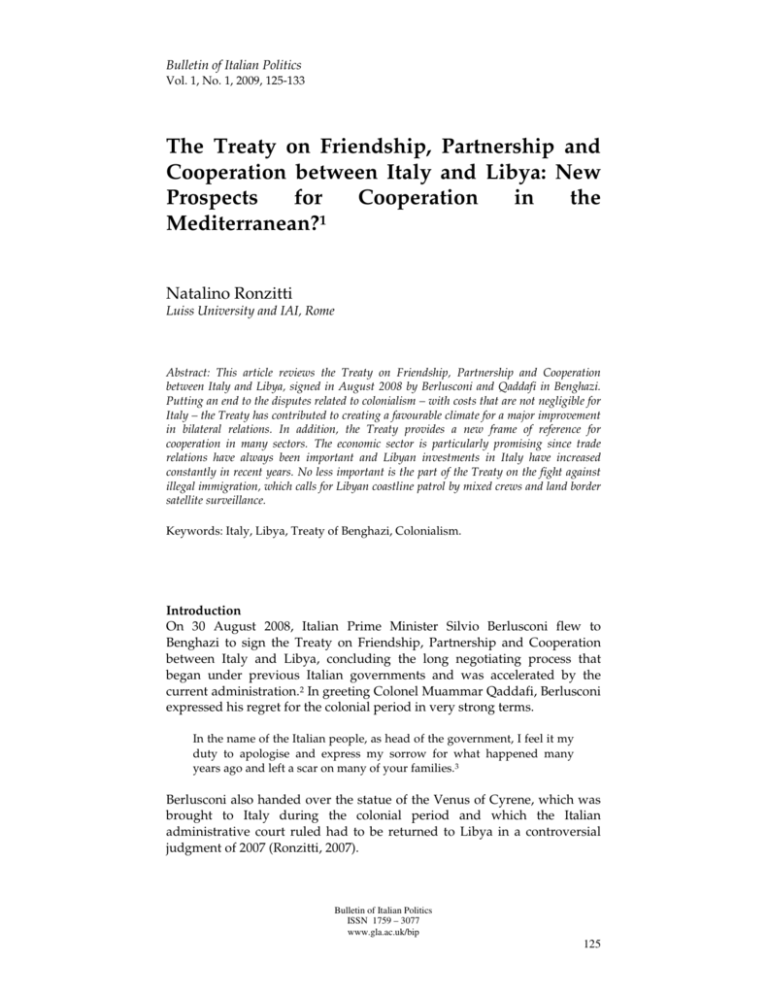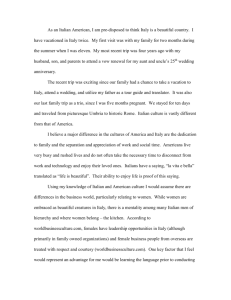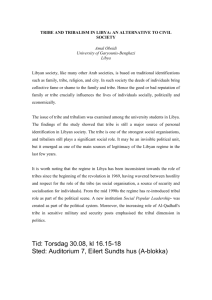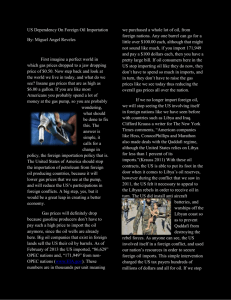The Treaty on Friendship, Partnership and Cooperation between
advertisement

Bulletin of Italian Politics Vol. 1, No. 1, 2009, 125-133 The Treaty on Friendship, Partnership and Cooperation between Italy and Libya: New Prospects for Cooperation in the Mediterranean?1 Natalino Ronzitti Luiss University and IAI, Rome Abstract: This article reviews the Treaty on Friendship, Partnership and Cooperation between Italy and Libya, signed in August 2008 by Berlusconi and Qaddafi in Benghazi. Putting an end to the disputes related to colonialism – with costs that are not negligible for Italy – the Treaty has contributed to creating a favourable climate for a major improvement in bilateral relations. In addition, the Treaty provides a new frame of reference for cooperation in many sectors. The economic sector is particularly promising since trade relations have always been important and Libyan investments in Italy have increased constantly in recent years. No less important is the part of the Treaty on the fight against illegal immigration, which calls for Libyan coastline patrol by mixed crews and land border satellite surveillance. Keywords: Italy, Libya, Treaty of Benghazi, Colonialism. Introduction On 30 August 2008, Italian Prime Minister Silvio Berlusconi flew to Benghazi to sign the Treaty on Friendship, Partnership and Cooperation between Italy and Libya, concluding the long negotiating process that began under previous Italian governments and was accelerated by the current administration.2 In greeting Colonel Muammar Qaddafi, Berlusconi expressed his regret for the colonial period in very strong terms. In the name of the Italian people, as head of the government, I feel it my duty to apologise and express my sorrow for what happened many years ago and left a scar on many of your families.3 Berlusconi also handed over the statue of the Venus of Cyrene, which was brought to Italy during the colonial period and which the Italian administrative court ruled had to be returned to Libya in a controversial judgment of 2007 (Ronzitti, 2007). Bulletin of Italian Politics ISSN 1759 – 3077 www.gla.ac.uk/bip 125 N. Ronzitti Past record The provisions of the Benghazi agreement were already contained in nuce in the 4 July 1998 Joint Communiqué signed for Italy by then Foreign Minister Lamberto Dini as a premise for an agreement with broader political scope. However, the ups and downs in Italian-Libyan relations prevented such an agreement from being concluded, in spite of the efforts of all governments in the following decade, including those of the centre left. Relations with Libya have never been easy, both because of the colonial heritage and because of the embargo imposed on Libya by western countries. After Qaddafi’s rise to power in 1969, Italians were thrown out of the country and their property confiscated. Nevertheless, trade relations continued thanks to Italy’s oil and gas company, the National Hydrocarbon Corporation (Ente Nazionale Idrocarburi, ENI), which maintained a constant presence in the country, even during the years of international terrorism and sanctions on Libya, and, of course, Libyan investments in Fiat (Varvelli, 2009a). Italy-Libya relations reached an all time low in 1986, when Libya launched a missile which fell into waters close to the island of Lampedusa in reprisal for the US bombing of Tripoli and Benghazi. The aircraft had not taken off from Italian bases nor flown over Italian territory, but according to Qaddafi, they had made use of the US transmission station situated on the island. There had also been clashes with the United States in preceding years because of the transit and exercises of the US 6th Fleet in the Gulf of Sidra, which Libya claims is a historic bay and therefore part of its national waters. Libya was accused of supporting international terrorism and Libyan agents were suspected of having provoked the airplane crashes in Lockerbie (1988) and Niger (1989), involving Pan Am (US) and Uta (France) aircraft, respectively. Internationally isolated, Libya was forced to hand over the presumed terrorists to a Scottish court sitting in the Netherlands and to pay considerable damages to the victims’ families. The Security Council imposed sanctions on Libya in 1992 and only revoked them in 2003, after Libya took on the commitment, in a letter addressed to the Security Council, not to participate directly or indirectly in perpetrating acts of international terrorism and declared that it was giving up its programme for the construction of weapons of mass destruction. The European Union had also placed an embargo on Libya in 1986. It is interesting to note that the Preamble of the 2008 Italy-Libya agreement mentions “Italy’s important contribution in bringing the embargo to an end”. The United States only restored diplomatic relations with Libya in 2005. Qaddafi’s Africa policy also caused problems, with the intervention in the civil war in Chad and the clashes with the factions supported by France. Not to speak of Libya’s claims on the Aouzou strip, which was only 126 The Friendship Treaty between Italy and Libya returned to Chad in 1994, following a judgment by the International Court of Justice.4 Opportunities and challenges of the new Italian-Libyan framework of cooperation The normalisation of Italian-Libyan relations with the conclusion of the Treaty of Benghazi was preceded by a number of bilateral agreements, which nevertheless left many questions unanswered: from Libyan requests for reparations for the damages caused by colonialism to the credit due Italian firms for work that was carried out but never paid. Not to mention the delicate matter of illegal immigration, regulated by a bilateral agreement of December 2000 on the fight against terrorism, organised crime and illegal immigration, which came into force in December 2002, and the two Protocols of 29 December 2007, which were not implemented.5 In any case, a framework agreement was still missing. Like previous treaties, the 2008 Treaty is in Italian and Arabic. Both texts are authentic. The Treaty is an ambitious document emphasising the “special and privileged” relationship that the two countries intend to develop, without forgetting the roles that they pursue, respectively, in the European Union and the African Union. The Treaty is made up of three parts: general principles; closing with the past and ending the disputes; partnership. It begins with a long preamble which sets down, among other things, the will to close with the “painful ‘chapter of the past’ for which Italy has already expressed its regret for the suffering that Italian colonisation caused the Libyan people”. In short, Libya has managed to receive a “condemnation” of Italian colonialism, which is reflected in several of the Treaty’s provisions. The reference to regional cooperation is also significant. This is attested to by the negotiations for a framework agreement between the European Union and Libya which started in November 2008. A good part of the section dedicated to the principles repeats norms deriving from international customary law or the UN Charter, to which the Treaty constantly refers: respect for sovereign equality, prohibition of the threat or use of force, non interference in internal affairs, respect for human rights and fundamental freedoms. But some clauses are not that “neutral”. For example, the prohibition on carrying out hostile acts launched from the respective territories triggered speculation in the media that this was incompatible with Italy’s membership in NATO. Actually, this is not a “nonaggression” pact and it is therefore not incompatible with the NATO Treaty, should Libya act outside of “international legality” as laid down in the provision. Nevertheless, more complex instances can be envisaged and 127 N. Ronzitti problems could arise should the US fleet, after leaving bases in Italy, navigate in the Gulf of Sidra to reassert the freedom of the high seas. The reference to international law at the beginning of the provision is meant to protect operations in self-defence or under UN authorisation that set out from Italian territory. The notion of “international legality”, an unusual expression for diplomatic documents, is repeated in the last provision of the Treaty and constitutes the framework in which relations between the two countries are to unfold. Another interesting provision is the one on human rights and fundamental freedoms contained in Article 6, which refers to Article 14 of the Universal Declaration of Human Rights. The reference to the Declaration and to the UN Charter is supposed to allow Italy to ask that they be respected, even though the Declaration is not a legally binding instrument. Also worthy of mention is the third paragraph of Article 19, which commits the parties to collaborating to prevent illegal immigration in the countries of origin of the migratory flows through bilateral and regional initiatives. Among other things, Libya is a party to all the most important international human rights treaties, with the exception of the 1951 Convention on Refugees, as well as being party to the 1981 African Charter on Human and People’s Rights, which contains provisions on the treatment of foreigners. The second part of the Treaty – closing with the past – is the most onerous. Italy is committed to building basic infrastructure for a total of $5 billion. The annual expenditure will amount to $250 million over 20 years, to be raised through an increase in IRES (Imposta sul reddito delle società), the tax on company income, of firms operating in the field of hydrocarbon research and development, headquartered in Italy, and with a capitalisation of over €20 billion, basically ENI. It is hard to predict how much this will amount to, as it depends on market conditions, without considering the risk of nationalisation of energy sources being rumoured in Libya because of the fall in oil prices.6 The work will be carried out by Italian companies with funds managed directly from Italy. Consequently, no funds will be transferred to Libya. Since the work will be carried out in a non-EU country, EC legislation relative to contracts does not hold and the exclusive restriction favouring Italian companies is fully legitimate. But 20 years are a long time, and the matter will have to be managed by the joint commission envisaged by the Treaty for that purpose with wisdom and common sense. Less onerous but still Italy’s responsibility are the “special initiatives” for “the benefit of the Libyan people”, such as scholarships, rehabilitation of victims of mine explosions and the return of archaeological artefacts shipped to Italy during the colonial period. Italy’s commitments are substantial. What are the benefits? There is a commitment to reach an agreement within a joint committee for payment of the sums still due to Italian companies. The sum, generally quantified as 128 The Friendship Treaty between Italy and Libya €620 million has not been laid down anywhere, nor has the time in which it is to be repaid. Since Italian entrepreneurs have also accumulated fiscal and administrative debts, there is the risk that the compensation will not be sufficient. Some say that Italy could deduct the sum due to Italian entrepreneurs from the instalments to be paid for building infrastructures in Libya, should that country not pay up. But this would mean the end of the Treaty. Furthermore, from a strictly legal point of view, it is difficult to rely on this kind of mechanism, since the sum claimed by the Italian entrepreneurs has not been set down (at least in the Treaty) while the one for the infrastructure projects has. Another thorny question concerns Italian people expelled from Libya. The Treaty does not provide for compensation to the approximately 20,000 Italians driven out of Libya in July 1970 after Qaddafi came to power. Italy basically seems to have dropped the matter. In order to make up for this injustice, the law authorising the ratification and execution of the Treaty,7 introduces a procedure for compensation: Italy will pay out €150 million, a sum slightly higher than the one agreed upon in Law 1066/1971, but which still does not entirely cover the sum claimed by those who were expelled from Libya. Under the treaty, they are the object only of an ad hoc nonfinancial provision. Until now, Libyan legislation prohibited them from entering the country. Now, Article 11 of the Treaty obliges Libya to grant them visas for tourism, work or other purposes. This provision also applies to the Italian citizens who voluntarily left the country before the expulsion was ordered (Varvelli, 2009b). The partnership and the immigration chapter The most ambitious part of the Treaty is the one on partnership. Mainly of a programmatic nature, it does not allocate any funds, except for the fight against illegal immigration. Cooperation is envisaged in many sectors: culture, science, economy, industry, energy, defence, non-proliferation and disarmament, the fight against terrorism and illegal immigration. The Treaty actually foresees the possibility of making the Mediterranean a weapons of mass destruction-free zone in “full respect of the obligations deriving from international agreements and treaties on the matter”. Yet, it is doubtful that that provision can be considered a commitment in favour of denuclearised zones or of turning the Mediterranean into a nuclear weapons-free zone. Nevertheless, this provision may gain new vigour with the “zero option” put forward by US President Barack Obama during the April 2009 NATO summit. The provision of most immediate interest is the one that concerns the fight against illegal immigration, in particular via sea. This phenomenon, according to recent statistics from the Italian Ministry of the Interior, was 129 N. Ronzitti on the increase in the initial months of 2009 with respect to the previous year (la Repubblica.it, 24 April 2009). Article 19 of the Treaty calls for two things in this respect. On the one hand, previous agreements and protocols on immigration, in particular those stipulated in 2007, are to be implemented, and the approximately 2000 km of Libyan coast patrolled by mixed crews on patrol boats provided by Italy. Six patrol boats were supposed to enter into operation on 15 May 2009.8 On the other, Libyan land borders are to be controlled by a satellite detection system jointly financed by Italy and the European Union. The system is quite expensive – even though the financial commitment has not yet been determined – but it does not involve the deployment of Italian police forces. This is the part of the Treaty that raised the strongest human rights concerns about the fate of the immigrants turned back and left in the desert. Italy and Libya are both parties to the 2000 UN Protocol against organised crime to combat the trafficking of human beings via land, sea and air.9 However, Libya, as said before, is not party to the 1951 Convention on refugees, even though it has ratified regional and universal instruments that safeguard human rights. As seen, the partnership involves complex commitments that will have to be further defined during implementation. To that end, management bodies had to be set up: • a Partnership Committee composed of the Prime Minister of Italy and the Secretary of the General People’s Committee in Libya, which will meet annually, alternately in Italy and Libya. The Committee adopts the provisions needed to implement the Treaty; • an Implementation Committee at the Minister of Foreign Affairs level in Italy and the Secretary of the General People’s Committee for foreign affairs and international cooperation in Libya, which will also meet annually, alternating between Italy and Libya. Extraordinary meetings can also be held, upon request of the party with complaints about breaches of the Treaty. In this case, the Committee functions like a dispute-settlement mechanism; • regular consultations between the parties. The Treaty entered into force on 2 March 2009, when ratifications were exchanged during Prime Minister Berlusconi’s visit to Sirte (IlSole24Ore.com, 2 March 2009). The Partnership in practice between economic interests and domestic dynamics How can the Italy-Libya Treaty be assessed? First of all, given the programmatic nature of many of its provisions, much will depend on how it is implemented. This will in turn depend on the will of the two parties and developments in the Libyan regime. 130 The Friendship Treaty between Italy and Libya The lack of a western-type democracy in Libya is well known. As a result, the focus will be on what kind of domestic fallout this broad process of diplomatic normalisation between Libya and the West will have in terms of the adoption of a modern Constitution and the implementation of the principle of the separation of powers. Undoubtedly, the Treaty has substantial “costs” for Italy, but on the whole it represents a good framework for a real partnership. Libyan investment in Italy is on the rise. The government in Tripoli has activated its diplomatic channels to organise a meeting to determine into which sectors and which Italian firms to channel fresh capital from Libyan sovereign funds. The Libyan Central Bank and the sovereign Libyan Investment Authority (LIA) have bought 4.9 per cent of the financial institution, Unicredit, and are about to buy up to 5 per cent of ENI. Other investments on the horizon include an important share in the telecoms company, Telecom Italia (la Repubblica, 13 February 2009). The Libyans, however, are not interested only in large works. During a meeting of the Libyan Minister of Planning and LIA president, Abdul Hafiz Zlitni, Prime Minister Berlusconi and Minister of the Economy Giulio Tremonti, on 12 February 2009, the Libyans were interested in learning more about the Italian industrial system, in particular small and mediumsized businesses, as a way to help Libya develop new modern industrial districts. This is also part of the strategy Qaddafi intends to follow to fulfil his commitment to concentrate 90 percent of Libya’s foreign investment in Italy and to give priority to Italian businesses that want to operate in Libya (Il Sole 24 Ore, 3 March 2009). Given the concrete interest manifested by Italian firms, the Special Agency for international activity of the Milan Chamber of Commerce organised a multi-sectoral mission to Libya for entrepreneurs between 1 and 3 April 2009. Conclusion The Treaty of Friendship, Partnership and Cooperation between Italy and Libya marks the conclusion of long negotiations on diplomatic normalisation between the two countries coinciding with the end of sanctions on Libya. Closer bilateral ties between Italy and Libya can boost Libya’s integration into the circuit of international cooperation at various levels. The colonial heritage has long conditioned Italo-Libyan relations, curbing their growth and periodically triggering tensions. Putting an end to the disputes related to Italian colonialism – with “costs” that are not negligible for Italy – the Treaty has contributed to creating a favourable climate for a major improvement in bilateral relations. In addition, the Treaty provides a new frame of reference for cooperation in many sectors. 131 N. Ronzitti The economic sector is particularly promising since trade relations have always been important and Libyan investments in Italy have increased constantly in recent years. No less important is the part of the Treaty on the fight against illegal immigration, which calls for Libyan coastline patrol by mixed crews and land border satellite surveillance. As past experience proves, cooperation in this sector is difficult. According to some commentators, the approach envisaged in the Treaty would raise serious human rights concerns, in particular about the fate of immigrants turned back. In general, the provisions on Partnership of the Treaty are mainly programmatic. Some of the more complex commitments will have to be defined in more detail and the transition to their implementation will not be easy. In the past, various bilateral agreements have remained a dead letter. Much will depend on the internal dynamics of the Libyan regime, and the evolution of its regional policies and its relations with other international actors. Italy will in any case, thanks also to this new Treaty, be able to make an important contribution to the consolidation that has opened the door to new relations between Libya and the West. References Ronzitti, N. (2007), “Sugli obblighi di restituzione dell’Italia la sentenza amministrativa non convince”, Guida al Diritto. Il Sole 24 ore, 21, 100. Ronzitti, N. Il Trattato Italia-Libia di amicizia, partenariato e cooperazione, study prepared for the Italian Senate, Rome: Senato della Repubblica, Servizio Studi, Servizio Affari Internazionali, Dossier no. 108, January . Varvelli, A. (2009a). L’Italia e l’ascesa di Gheddafi. La cacciata degli italiani, le armi e il petrolio (1969-1974), Milan: Baldini Castoldi Dalai, 2009. Varvelli, A. (2009b), “Il Trattato Italia-Libia e il nuovo contesto economico libico”, ISPI Med Brief no. 8, Milan: Istituto per gli Studi di Politica Internazionale, 23 September, www.ispionline.it/it/ documents/ Med_Brief_8_2008.pdf, accessed 5 May 2009. This is an edited version of an article that appeared in the Documenti IAI series, published by Istituto Affari Internazionali (IAI). The author is grateful to Silvia Colombo, junior researcher at the IAI, for her research assistance. 2 The text of the Treaty in Italian only is annexed to the law authorising the ratification and implementation (Law no. 7 of 6 February 2009). 3 All quotes have been translated from the Italian by the author. http://www.it/Presidente/Interventi/testo_int.asp?d=40139, accessed 5 May 2009. 4 ICJ Case concerning the Territorial Dispute (Libyan Arab Jamahiriya/Chad), Judgment of 3 February 1994. 1 132 The Friendship Treaty between Italy and Libya 5 See www.programmaintegra.it/modules/news/article.php?storyid=3468, accessed 5 May 2009. 6 See http://archiviostorico.corriere.it/2009/gennaio/25/Gheddafi_petrolio_ non_sale_nazionalizzo_co_9_090125075.shtml, accessed 5 May 2009. 7 8 See www.airl.it/Leggeratificatrattato.pdf, published in Gazzetta Ufficiale, no. 40 of February 18 2009, accessed 5 May 2009. 8 See www.interno.it/mininterno/site/it/sezioni/sala_stampa/gallery/2009 0954_2009_04_29_maroni_question_time/index.html, accessed 5 May 2009. 9 See www.admin.ch/ch/i/ff/2005/6077.pdf, accessed 5 May 2009. 133








